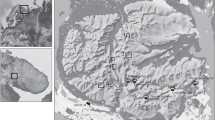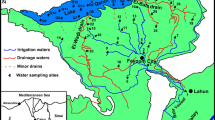Abstract
Migration of nutrients is studied in five drying salt lakes belonging to the Yevpatoriya Group (Crimea). The nutrients enter in the Crimean salt lakes from natural sources, in particular, atmospheric precipitation, erosion materials, seawater overflow during storms, products of vital activity of birds and animals grazing on coasts, processes in ecosystems (eutrophication and vital functions of aquatic organisms). Nitrogen and phosphorus are also supplied with runoff directly in water bodies and indirectly via ground waters, and recreation activity on the lake coasts. An increase of air temperature above +30°C in summer caused intense evaporation and drying up of the lakes. In drying water bodies, the natural processes of the nitrogen and phosphorus migration are terminated due to cessation of biota functioning, especially of microalgae, microbial communities and crustacean Artemia. In drying periods, nitrogen, phosphorus, and pollutants are accumulated and concentrated on the bottom sediments and during strong storms and winds are propagated over adjacent territory and, respectively, represent a threat to human health. The paper discusses the possible scenario of the transformation of ecosystems of saline lakes under possible climatic warming and increasing anthropogenic impact.













Similar content being viewed by others
REFERENCES
K. M. Akhmedenov, “Tourist and recreational potential of the salt lakes of Western Kazakhstan,” Geol. J. Tourism and Geosites 30 (2), 782–787 (2020).
V. Amiri, M. Nakhaei, R. Lak, and M. Kholghi, “Investigating the salinization and freshening processes of the coastal groundwater resources in Urmia aquifer, NW Iran,” Environ. Monitor. Assess. 188 (4), Article N 233 (2016).
D. Bamba, M. Coulibaly, and D. Robert, “Nitrogen-containing organic compounds: origins, toxicity and conditions of their photocatalytic mineralization over TiO2,” Sci. Total Environ. 580, 1489–1504 (2017).
S. C. Chapra, A. Dove, and G. T. J. Warren, “Long-Term trends of Great Lakes Major ion chemistry,” J. Great Lakes Research. 38, 550–560 (2012).
N. Cherekarm and A. P. Pathak, “Chemical assessment of Sambhur Soda Lake, a Ramasar site in India,” J. Water Chem. Technol. 38(4), 244–247 (2016).
L. Di Meglio, F. Santos, M. Gomariz, C. Almansa, C. López, J. Antón, and D. Nercessian, “Seasonal dynamics of extremely halophilic microbial communities in three Argentinian salterns,” FERMS Microbiol. Ecol. 92 (12), Article fiw184 (2016).
V. V. Ezhov and D. N. Tarasenko, Secrets of Crimean Health (Biznes-Inform, Simferopol, 2002) [in Russian].
K. A. Fisher J. J. Meisinger, and B. R. James, “Urea hydrolysis rate in soil toposequences as influenced by pH, carbon, nitrogen, and soluble metals,” J Environ Qual. 45 (1), 349–359 (2016).
Ch. Geldenhuys, Ph. Cotiyane, and A. Rajkaran, “Understanding the creek dynamics and environmental characteristics that determine the distribution of mangrove and saltmarsh communities at Nahoon Estuary,” South Afr. J. Botany. 107, 137–147 (2016).
P. M. Glibert E. Mayorga, and S. Seitzinger, “Prorocentrum minimum tracks anthropogenic nitrogen and phosphorus inputs on a global basis: Application of spatially explicit nutrient export models,” Harmful Algae 8 (1), 33–38 (2008).
R. Golan, I. Gavrieli, J. Ganor, and B. Lazarc, “Controls on the pH of hyper-saline lakes – A lesson from the Dead Sea,” Earth Planet. Sci. Lett. 434, 289–297 (2016).
O. A. Gulov, Complex Reconnaissance of Study of Largest Deposits of the Crimean Therapeutic Mud. Report on the Geoecological Works (GGRES, Saki, 2006) [in Russian].
O. A. Gulov, Ecocyde of Crimean Salt Lakes. Theory and Practice of Recovery of Internal Lakes (Lema, St. Petersburg, 2007), pp. 60–78 [in Russian].
L. Guo, J. Z. Zhang, and C. Guéguen, “Speciation and fluxes of nutrients (N, P, Si) from the upper Yukon River,” Global Biogeochem. Cycles. 18, 1–12 (2004).
Y. Hetzel, C. Pattiaratchi, R. Lowe, and R. Hofmeister, “Wind and tidal mixing controls on stratification and dense water outflows in a large hypersaline bay,” J. Geophys. Res. Oceans. 120(9), 6034–60556 (2015).
J. Huang, C.-C. Xu, B. G. Ridoutt, X.-C. Wang, and P.‑A. Ren, “Nitrogen and phosphorus losses and eutrophication potential associated with fertilizer application to cropland in China,” J. Cleaner Prod. 159, 171–179 (2017).
N. M. Ivanyutin, “Influence of anthropogenic activity on the groundwaters of Crimea,” Puti Povysh. Orozhaem. Zemledeliya 3 (59), 25–31 (2016).
N. M. Ivanyutin and S. V. Podovalova, “Contamination of water bodies of Crimea by waste waters,” Ekol. Stroit. 1, 4–8 (2018).
R. Jellison, W. D. Williams, B. Timms, and N. V. Aladin, “Salt lakes: values, threats, and future,” Aquatic Ecosystems: Trends and Global Prospects (Cambridge University Press, Cambridge, 2008), pp. 94–110.
V. A. Khokhlov, V. I. Vasenko, V. V. Chaban, et al., Geoecological Study, Regime, Exploitation, and Mountainous–SanitaryProtection of Deposits of Hydromineral Resources of Republic of Crimea in the action zone of Crimean SDPP. Report on the Scientific-Practical Work for 2018 (Krymskaya GGRES, Saki, 2019) [in Russian].
V. Lazar, C. Iordache (Curutiu), L. M. Ditu, A. Holban, I. Gheorghe, F. Marinescu, M. Ilie, A. Ivanov, D. Dobre, and M. Chifiriuc, “Physico-chemical and microbiological assessment of organic pollution in Play Salty lakes from protected regions,” J. Environ. Protect. 8, 1474–1489 (2017).
H. Liu, Z. Chen, Y. Guan, and S. Xu, “Role and application of iron in water treatment for nitrogen removal: a review,” Chemosphere 204, 51–62 (2018).
C. S. Mantyka-Pringle, T. G. Martin, D. B. Moffatte, et al., “Prioritizing management actions for the conservation of freshwater biodiversity under changing climate and land-cover,” Biol. Conserv. 197, 80–89 (2016).
Mass Concentration of Nitrates in Waters. Potentiometric Measurement with ion-selective electrode. RD 52.24.367-2010.
Mass Concentration of Phosphates and Polyphosphates in Waters Photometric Measurements. RD 52.24.382-2006.
S. Mitchell, I. Boateng, and F. Couceiro, “Influence of flushing and other characteristics of coastal lagoons using data from Ghana,” Ocean Coast. Manag. 143 (1), 26–37 (2017).
T. I. Moiseenko, “Evolution of biogeochemical cycles under anthropogenic loads: limits impacts,” Geochem. Int. 55 (10), 841–860 (2017).
T. I. Moiseenko and N. A. Gashkina, Formation of Chemical Composition of Lacustrine Waters under Environmental Changes (Nauka, Moscow, 2010) [in Russian].
T. I. Moiseenko and I. I. Rudneva, “Global pollution and nitrogen functions in the hydrosphere,” Dokl. Earth Sci. 420 (3), 676–680 (2008).
I. Pepenel, N. Cracium, V. Jujea, A. Florea, C. E. Pop, and G. Stoian, “Biochemical parameters of salt lakes sapropelic sludge from Buzau Country protected area, with different degrees of microbiological attrition,” Sci. Annals Danube Delta Ins. 25. 101–111 (2020).
Photometric Determination of Nitrite-Ions in Potable, Surface, and Waste Waters using Griess Reagent. PNDF 14.1:2: 4.3-95. 1995.
A. M. Ponizovskii, Saline Resources of Crimea (Krym, Simferopol, 1965) [in Russian].
M. Ravurmaci and A. K. Ustun, “Assessment of groundwater quality using DEA and AHP: a case study in the Serefkikochisar region in Turkey,” Environ. Monitor. Assess. 188 (4). Article N 25 (2016).
J. Ch. Robert and S. Emerson, “The acid-base and oxidation–reduction balances of the Earth,” Int. Geophys. 72. 421–436 (2000).
I. I. Rudneva, I. N. Zalevskaya, V. G. Shaida, G. N. Memetlaeva, and A. V. Scherba, “Biogenic migration of nitrogen and phosphorus in Crimean hypersaline lakes: a seasonal aspect,” Geochem. Int. 58 (10), 1123–1134 (2020).
R. Santanu, J. Mukherjee, and S. Mandai, “Modelling nitrogen and carbon cycles in Hooghy estuary along with adjacent mangrove ecosystem,” Develop. Environ. Model. 27, 289–320 (2015).
J. R. Selemani, J. Zhang, A. N. N. Muzuka, K. N. Njau, G. Zhang, M. K. Mzuza, and A. Maggid, “Nutrients’ distribution and their impact on Pangani River Basin’s ecosystem—Tanzania,” Environ. Technol. 39(6), 1–15 (2018).
S. Shadkam, F. Ludwig, T. H. van Vliet, A. Pastor, and P. Kabat, “Preserving the world second largest hypersaline lake under future irrigation and climate change,” Sci. Total Environ. 559, 317–325 (2016).
V. S. Tarasenko, Ecology of Crimea. Hazards to Steady Development. Plan of Activities (Arial, Simferopol’, 2014) [in Russian].
K. Tusupova, A. Peder Hjorth, and M. Morave, “Drying lakes: a review on the apllied restoration strategies and health conditions in contiguous areas,” Water 12 (749), 1–21 (2020).
V. I. Vasenko, Results of Reconnaissance Study of Lake Moinaki. Report of SGGRES (Saki, 2012) [in Russian].
Z. Wang, J. Zheng, J. Tang, X. Wang, and Z. Wu, “A pilot-scale forward osmosis membrane system for concentrating low-strength municipal wastewater: performance and implications,” Sci. Rep.-UK. 6, Article No. 21653 (2016).
T. H. Wooldridge, J. B. Adams, and M. Fernandes, “Biotic responses to extreme hypersalinity in an arid zone estuary,” South Afr. J. Botany 107, 160–169 (2016).
W. A. Wurtsbaugh, C. Miller, S. E. Null, R. J. DeRose, P. Wilcock, M. Hahnenberger, F. Howe, and J. Moore, “Decline of the world saline lakes,” Nat. Geosci. 10. 816–821 (2017).
Funding
This work was supported by the government-financed program of the Kovalevsky Institute of the Biology of Southern Seas, Russian Academy of Sciences (project no. АААА-А18-118021490093-4 Functional, Metabolic, and Toxicological Aspects of the Existence of Aquatic Organisms and their Populations in Biotopes with Different Physicochemical Regime).
Author information
Authors and Affiliations
Corresponding authors
Ethics declarations
The authors declare that they have no conflicts of interest.
Additional information
Translated by M. Bogina
Rights and permissions
About this article
Cite this article
Rudneva, I.I., Zalevskaya, I.N., Shaida, V.G. et al. Biogenic Migration of Nitrogen and Phosphorus in Saline Drying Lakes in Crimea. Geochem. Int. 60, 170–182 (2022). https://doi.org/10.1134/S0016702922020082
Received:
Revised:
Accepted:
Published:
Issue Date:
DOI: https://doi.org/10.1134/S0016702922020082




